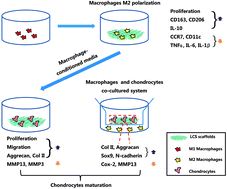Lithium silicate-based bioceramics promoting chondrocyte maturation by immunomodulating M2 macrophage polarization†
Abstract
Articular cartilage lesions occur frequently but unfortunately the damaged cartilage has a very limited intrinsic repair capacity. Since the cartilage damage can cause sterile inflammation, the effects of inflammation on cartilage repair should be well understood for precise treatment. Our previous study showed that bioceramics play an important role in cartilage regeneration. However, it is unclear how the immune microenvironment induced by bioactive ceramics influences cartilage regeneration. In this study, we applied the model bioactive ceramic lithium calcium silicate (Li2Ca4Si4O13, LCS) to prepare scaffolds and explore whether LCS scaffolds could promote cartilage maturation by regulating macrophage polarization. It was found that LCS induced the shifting of macrophages to anti-inflammatory M2 phenotype by downregulating the expressions of inflammatory genes TNFα, IL-6 and IL-1β and promoting the expression of IL-10 genes. The conditioned medium from LCS-treated macrophages promoted the proliferation, migration and maturation of chondrocytes. In a chondrocyte and macrophage co-culture system, LCS scaffolds induced chondrocyte maturation. These results demonstrated that LCS significantly promoted chondrocyte maturation by immunomodulating the M2 macrophage polarization. Hence, LCS scaffolds have great potential in cartilage repair, indicating that bioceramics may be used in cartilage regeneration due to their immunomodulatory effects on macrophages.



 Please wait while we load your content...
Please wait while we load your content...